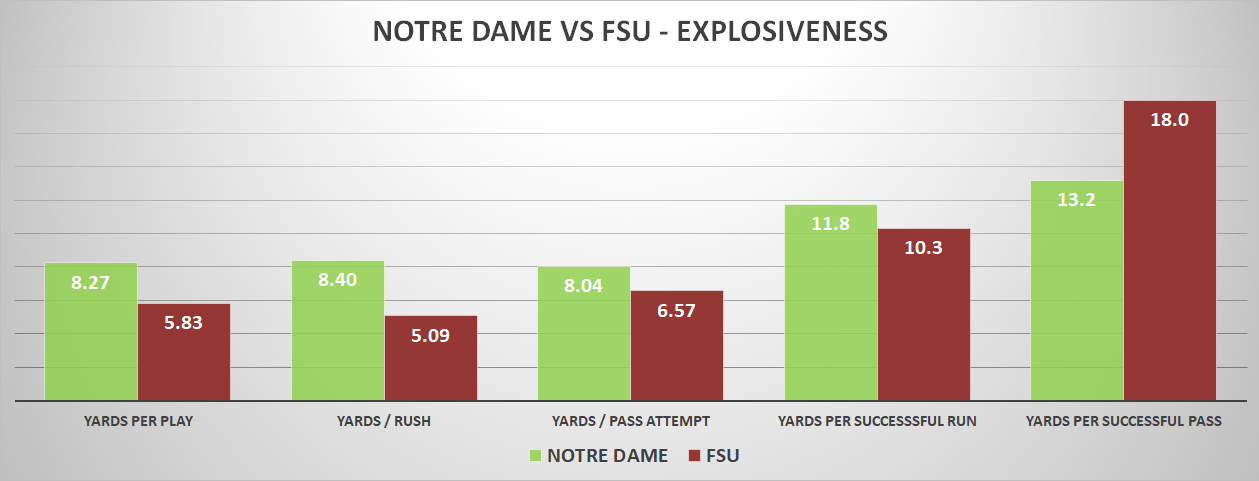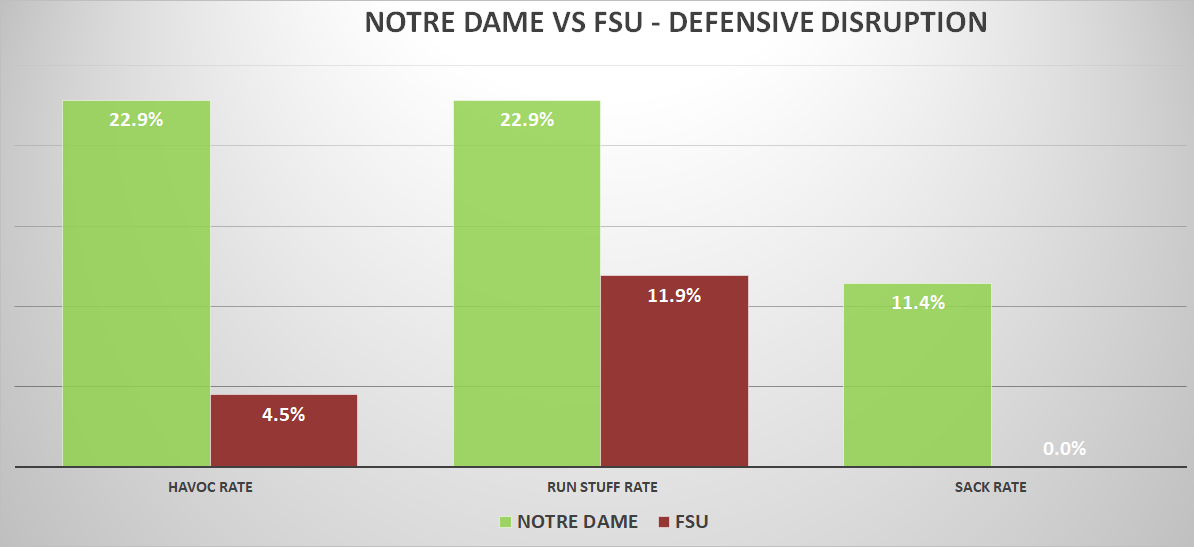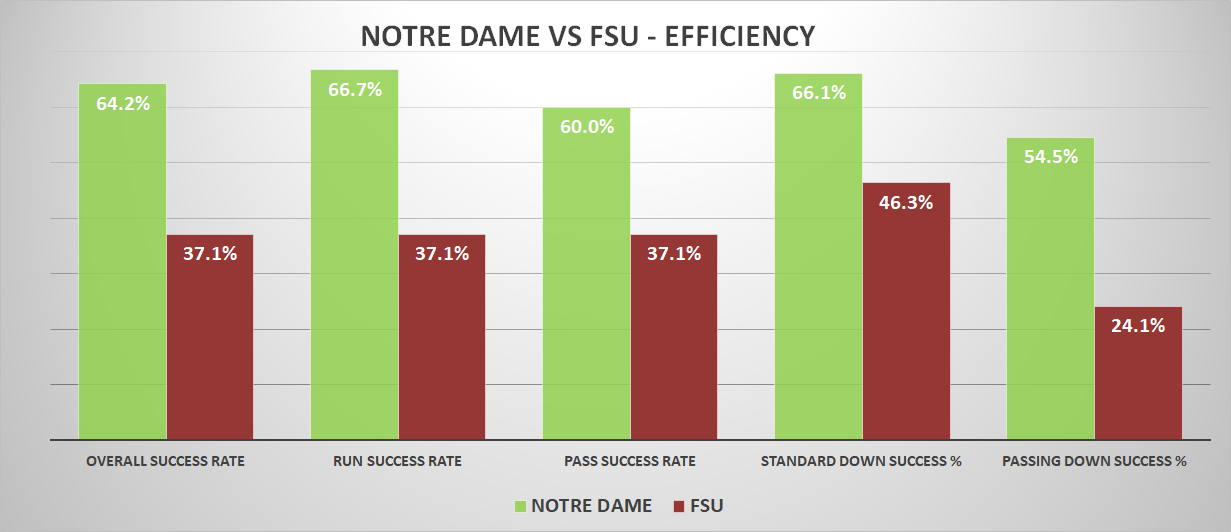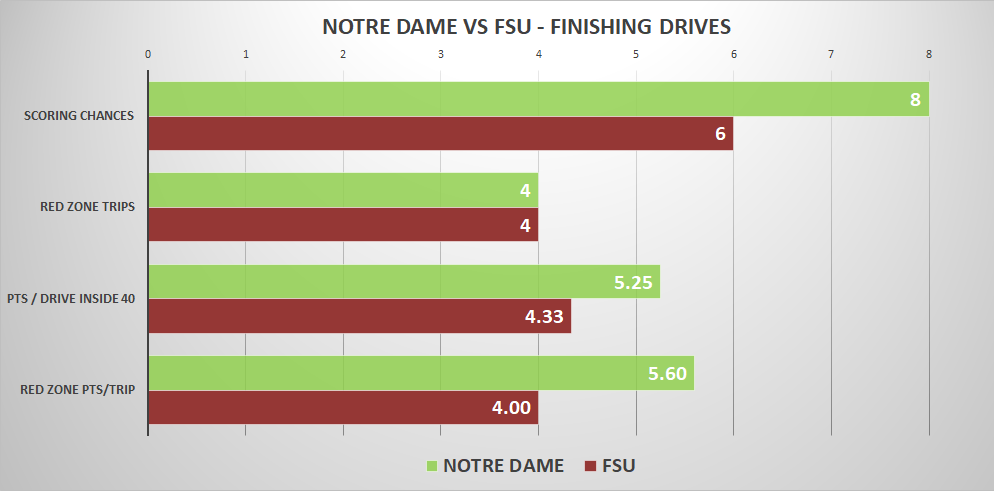The Irish nearly matched their offensive efficiency against USF versus a far more talented opponent and threw in more explosive plays for good measure. Defensively, the effects of a two-week lull were far more visible as Clark Lea’s typically steady unit was boom (with havoc and three-and-outs) and bust (giving up chunk plays).
Confused? Check out this handy advanced stats glossary here or reach out in the comments. No garbage time in this game, as it just barely stayed within 22 points throughout the 4th quarter, so all plays counted in the numbers below (minus FSU’s end of half kneel down).
Explosiveness

The most hand-wringing after this game was about the defense, so let’s start there. One could argue this wasn’t as bad as it looked, as turnovers gifted the Noles two instant scoring opportunities that were converted into 10 points. FSU’s offensive line actually held up better than expected, likely aided by Jordan Travis’s legs. It wouldn’t be surprising if Mike Norvell is able to manufacture better performance through the rest of the year after the intense struggles against Georgia Tech and Miami before the QB change.
But the underlying numbers weren’t great either. Florida State had just below average efficiency, but an offense that looked totally inept at Miami routinely broke off explosive plays. Allowing 6.6 yards per pass attempt (counting sacks) would have been the second-highest mark in all of 2019, trailing only UGA. The hallmark of a Lea defense has been forcing less talented defenses to put together long drives and limiting explosive plays. But Notre Dame gave up just four pass plays of 40+ yards in all of 2019 and is already halfway to that mark in 2020 despite playing three teams without great passing attacks.
The context matters though – Kyle Hamilton tied for the team-high with 8 tackles, yet looked like a player who hadn’t played in a month and wasn’t his sharpest. Jack Kiser and Myron Tagailova-Amosa didn’t play. Shaun Crawford had to slide to corner with COVID impact limiting Nick McCloud and Clarence Lewis significantly. The rotations were fairly deep on Saturday as despite the heartburn and mistakes the drama was more for bettors than Irish fans doubting they’d move to 3-0.
Still, it’s worth monitoring as the Irish head into their toughest offensive test yet against Louisville. Like the Noles, the Cardinals have a very leaky line (allowing nearly 10 TFL per game) but can make up for it with explosiveness at the skill positions, and Malik Cunningham is in a different tier than Travis. A return to the usual bend but don’t break against Tutu Atwell and Javian Hawkins and company would be a welcome sight.

Offensively, the Irish made sure that the defensive inconsistency didn’t matter, creating eight scoring chances on 12 possessions. The run game was incredibly explosive, with three runs of over 45 yards. Yet the passing game kept pace, as both the air and ground game averaged over 8 yards per play. Notre Dame continues to be very hard to disrupt – the Irish have a run stuff rate of just 13% (top 10 level, using 2019 numbers), have had very few passes broken up, and haven’t allowed a sack since Duke.
Efficiency

The run game dominance coincided with a vintage Ian Book performance, with hyper-efficient passing paired with strong run production. Book looked in control all game, moving around well in the pocket and on target in the short and medium pass game. While he didn’t break a long one, the QB chipped in 6.45 yards a carry, with successful runs on seven of nine attempts.
Kyren Williams is emerging as a back that helps in every way – he’s an explosive threat, but also is so elusive and hard to bring down that he manufactures efficient runs too. The redshirt freshman has been tackled for a loss on just one of 48 attempts despite defenders having far many opportunities to rack up a TFL. Notre Dame had passing downs (2nd and 8+, 3rd and 5+ to gain) on just 16.4% of snaps in this game compared to 41.4% of plays for FSU. That’s the run game making life easier for Book and keeping Tommy Rees’ playbook wide open!
There were many other bright spots for the offense:
- Chris Tyree broke the first of what should be many long touchdowns and showed he’s on a very quick learning curve with his patience and vision developing. He puts defenders in impossible situations – he’s so fast they have to try to take away angles to the sideline, but if he cuts inside Tyree can dust you there too. He had 8 successful runs of 11, and would have finished over 10 yards per carry if not for a couple failed goal-line attempts in the 4th quarter.
- Javon McKinley put on a nearly spotless performance, catching his first five looks (all successful) en route to 17.8 yards per target while continuing his strong blocking. Book has been at his best with a big-bodied receiver he trusts and can confidently hit with back-shoulder throws and gaps in zones between corners and safeties. If McKinley and Austin can together give that option consistently, or both at the same time if we get greedy, look out.
- It’s very early but playcaller Tommy continues to show a great feel for the game. Three drives that ended up with zero points featured tons of goodness – the Wilkins drop that was destined for tons of YAC, the screen to Williams that was just off but may have been six, and the late dominant running drive that was NC-17 between the blocking and RB play but ended up sputtering out at the two.
- Braden Lenzy didn’t fill up the box score but still opened things up and made life easier for the rest of the offense. It’s a near-impossible task to contain the Williams-Tyree combo, ensure Book isn’t going to keep an option and hurt you, and guard against a few Lenzy carries a game too.
One familiar sight defensively was the ability to shut down an opponent on passing downs, where the Noles were just 7 of 29 finding success. The problem was the number of drives where FSU was able to avoid passing downs – on their three touchdown drives, there was just one total passing down. The longest conversion needed was a 3rd and 4, the play where Tamorrion Terry beat Shaun Crawford with a double move – a play only possible thanks to a short down and distance that could get Crawford to bite.
Finishing Drives, Field Position, & Turnovers

The Irish were six for six converting scoring chances into touchdowns until late in the second half, when they came up with a couple of goose eggs. Let’s continue to hope these Jon Doerer misses are because he is bored and saving the makes for games where the Irish need it! The final Notre Dame drive was borderline garbage time, with eight straight successful plays that milked clock before finally stalling on 3rd and 4th and goal.
The field position battle ended up virtually deadlocked despite the early edge for the Seminoles. In the first quarter, FSU’s average starting field position was their own 44, versus Notre Dame at their own 25. The Irish kickoff coverage team had a pretty great day, and Jafar Armstrong a nice return to help smooth over the Lawrence Keys adventures catching punts.

This was an unlucky game with turnovers, as Notre Dame lost more than expected and gained fewer. Shaun Crawford snagged the first interception of the year after a few close calls, but the Irish are still due for more. ND is averaging 6.33 pass break-ups per game (tied for 6th nationally) but just one interception (59th among 76 teams that have played).




I was surprised to see the FSU run stuff rate so high. From about the middle of the first on, I was counting plays. Of course, I was at a ND GameWatch, drinking the official bear of ND football and enjoying wings courtesy of the official beer. While there were a couple of runs that went for 1 or 2 yards, it wasn’t until a run by C’Bo late in the third, and then one in the fourth that were for negative yards. The first negative yard play would have been the scramble by Book that had the late hit penalty. Does stuff include no gain or less than 2?
Yep stuffs include no gain and any runs for negative yardage. The last two runs of the game for ND at the goal line by Tyree (no gain on both) tacked on a couple late
Do we know how many went for negative yardage? I think there were a couple, and most of them only for 1 or 2 yards. It was an impressive line performance, helped by the ‘slipperiness’ of the backs on a couple of occasions. They made people miss in the backfield.